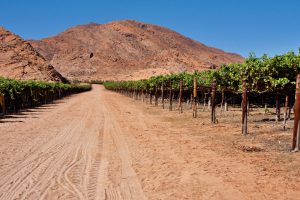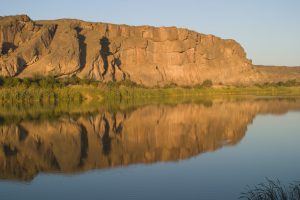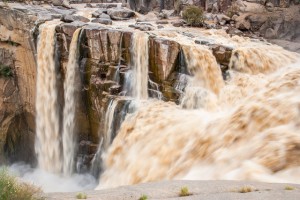The Northern Cape’s Green Kalahari, located on the banks of the deep blue Orange River, is a cool place to get lost for two days. It’s home to South Africa’s fastest growing wine region, which now produces some 10% of the country’s grapes. It’s also home the Northern Cape’s sixth tallest waterfall, Augrabies Falls, that thunders over a landscape resembling old photos of the moon. Here’s a 48-hour itinerary that makes the most of the what the Green Kalahari has to offer.
Day 1
We’ll start with wine, but to reach the wine we must first examine the water. Beginning in the craggy mountains of Lesotho, the Orange River is the region’s lifeblood. It heads west for more than 2,200-kilometers before emptying into the cold, dark waters of the Atlantic Ocean on the South African border with Namibia. But this source of hydrogen-and-oxygen molecules cuts an emerald path through the Northern Cape in South Africa’s orange landscape, turning the Kalahari sand into a fertile green ground on its banks. It’s what gives the area the Green Kalahari moniker and creates an ideal climate for growing wine grapes.
The fist vineyards in the Green Kalahari (which is centered around the towns of Keimos and Kakamas today), began in the early 1900s with the objective of producing raisins. The entrance into the wine making game was accidental, and didn’t come until the 1960s, when it was discovered the sultana grapes tasted much better pressed and fermented into wine, rather than eaten as raisins. Shortly after, the Orange River Wine Cellar Cooperative was born in 1965. The first wine grapes were harvested in Upington in 1968, and since then the co-op has grown to be the largest in South Africa, with about 750 members and five cellars concentrated along the N10 and N14. The cellars produce about 30 different products, including grape juice concentrates. Most of all the region is known for its delicious desert wines, and I love especially the earthy Jerepigo, which has a taste of pineapple and plum to it, or the sweet Muscadel that features earthy fruity undertones – think peach and apricot.
Spend the night in Kakamas, at the three-star Kalahari Gateway Hotel. It has oversized rooms with coffee tables and couches. Grab dinner at the zebra-themed restaurant and bar inside the hotel. It serves an assortment of steak and seafood dishes plus pasta, burgers and pizza.
Day 2
From Kakamas, head northwest for 38-kilometers on the sign-posted road to Augrabies Falls National Park, which is your destination for today.
The Khoesaan people called the world’s 6th tallest waterfall “Aukoerbis,” meaning place of great noise. And when the waterfall is heavy with rainy season run-off, the thunderous roar it emits borders on scary. Set in a rocky mosaic around an 18km ravine through which the Orange River flows, the main falls drop 56m, while the Bridal Veil Falls on the northern side drop 75m.
With rainfall averaging just 107mm per year and daytime summer temperatures often soaring above 40 degrees C, the climate in Augrabies Falls is harsh. As such, the plants you’ll find are desert oriented like kokerboom aloes and Namaqua figs, plus a few different types of thorn trees and succulents.
Get to know the local fauna on the three-hour Dassie Trail, which involves scrambling over rocks through a magical upside down landscape befit for an Alice in Wonderland sequel. While hiking, keep an eye out for the park’s 47 different mammal species, including the rock dassie. Note the animals living here are small and adapted to the hot rocky climate — you won’t see any lions or elephants here.
After you’ve seen the park, backtrack 10-kilometers towards Kakamas to your destination for the night. The popular, and well-run Augrabies Falls Backpakcers, run by the reputable Kalahari Outventures, a dynamic adventure company. It boasts a great reed bar for watching the distant thunderclouds build, and also features clean and comfortable private rooms with local art on the walls and animal print patterned bedding and an all-around super chill vibe. You can have dinner on the property – just sign up upon check-in – which are homemade, filling and very affordable.
Day 3
Spend the final morning doing the popular Augrabies Rush, where you’ll take an inflatable kayak down the wildest portion of the river around – the take out point is just 300 meters above the falls. Although the rapids are only a mild Class II and III, you can make the half-day trip more adventurous by paddling a single person boat. There’s a whole added thrill to being completely responsible for your destiny on the river.
If you want to expand your time on the river, ask about the companies two or four day wilderness canoe safaris down the Orange River. These start from the national park and offer a chance to explore a side of South African wilderness not often experienced.




